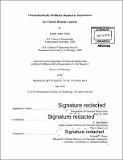| dc.contributor.advisor | T. Alan Hatton. | en_US |
| dc.contributor.author | Vicari, Kristin Jenise | en_US |
| dc.contributor.other | Massachusetts Institute of Technology. Department of Chemical Engineering. | en_US |
| dc.date.accessioned | 2016-09-13T19:13:20Z | |
| dc.date.available | 2016-09-13T19:13:20Z | |
| dc.date.copyright | 2016 | en_US |
| dc.date.issued | 2016 | en_US |
| dc.identifier.uri | http://hdl.handle.net/1721.1/104214 | |
| dc.description | Thesis: Ph. D., Massachusetts Institute of Technology, Department of Chemical Engineering, 2016. | en_US |
| dc.description | Cataloged from PDF version of thesis. | en_US |
| dc.description | Includes bibliographical references (pages 134-142). | en_US |
| dc.description.abstract | This thesis describes and analyzes several new designs for carbon dioxide (CO₂) separations using quinones in electrochemical cells. The intended application is carbon capture and sequestration. A quinone-ferrocene electrolyte is proposed as a novel chemistry for electrochemical carbon capture. Quantitative analyses are presented for two designs, and experimental results are provided for the quinone-ferrocene system in two configurations. The first design uses quinones for facilitated transport of CO₂ across a planar, supported liquid membrane. A mixture of quinone and dianion adduct is sandwiched between two porous electrodes. An analytical solution for the current-potential equation is derived and then used to quantify the expected performance of the system in terms of capacity and energy efficiency. In the second design, the electrolyte flows between the two planar electrodes of the electrochemical cell. Quinone reacts at the porous cathode to absorb CO₂ from the gas phase. The dianion adduct reacts at the nonporous anode to desorb the CO₂ , which produces supersaturated regions in the cell. The CO₂ evaporates and the electrolyte is recycled. A numerical model has been developed to solve for the spatial values of species concentrations, current, and ionic potential in the flowing electrolyte. A design analysis of this system highlights the quantitative impact of certain operating parameters and supports recommendations for future development. The first demonstration of an electrolyte that uses a quinone-ferrocene redox couple for carbon capture in a flow cell is presented. The quinone and ferrocene chemistries are introduced, and experimental results highlight the ability to couple quinone reduction to ferrocene oxidation and ferrocenium reduction to dianion-adduct oxidation using graphite electrodes. A bench-scale test cell has been designed and built to demonstrate electrochemical carbon capture in a cell with laminar flow of the electrolyte. The quinone-ferrocene couple is implemented in this flow design. Experimental results show the ability to continuously capture CO₂ from a gas stream (15% CO₂, 85% nitrogen (N₂)) using the quinone-ferrocene couple in this design. Finally, experimental results highlight the cycling of electrochemical absorption and desorption of carbon dioxide using the quinone-ferrocene chemistry in flow-through electrodes. | en_US |
| dc.description.statementofresponsibility | by Kristin Jenise Vicari. | en_US |
| dc.format.extent | 167 pages | en_US |
| dc.language.iso | eng | en_US |
| dc.publisher | Massachusetts Institute of Technology | en_US |
| dc.rights | M.I.T. theses are protected by copyright. They may be viewed from this source for any purpose, but reproduction or distribution in any format is prohibited without written permission. See provided URL for inquiries about permission. | en_US |
| dc.rights.uri | http://dspace.mit.edu/handle/1721.1/7582 | en_US |
| dc.subject | Chemical Engineering. | en_US |
| dc.title | Electrochemically-mediated membrane separations for carbon dioxide capture | en_US |
| dc.type | Thesis | en_US |
| dc.description.degree | Ph. D. | en_US |
| dc.contributor.department | Massachusetts Institute of Technology. Department of Chemical Engineering | |
| dc.identifier.oclc | 958140016 | en_US |
